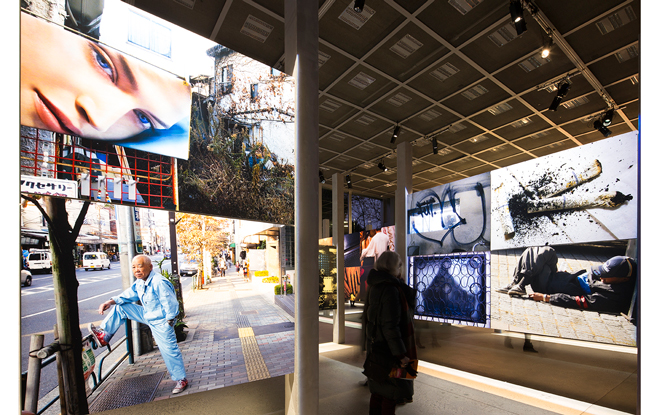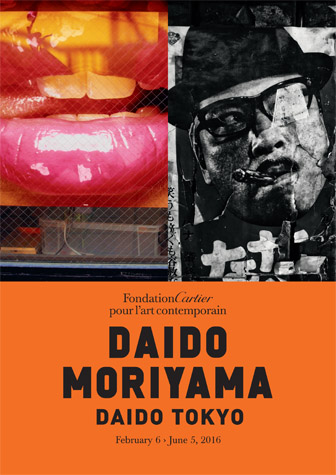Après avoir organisé en 2003 sa première grande exposition en France, la Fondation Cartier pour l’art contemporain consacre une nouvelle exposition à Daido Moriyama, figure centrale de la photographie japonaise. Daido Tokyo met à l’honneur le travail récent de l’artiste : en présentant un vaste ensemble de photographies couleur, l’exposition lève le voile sur un aspect méconnu et pourtant omniprésent dans son travail photographique depuis deux décennies. Daido Tokyo est également l’occasion pour la Fondation Cartier de commander au photographe une œuvre nouvelle : un diaporama inédit, réalisé avec des photographies noir et blanc et projeté sur plusieurs écrans, qui illustre à l’instar de ses photographies couleur, le flux constant de la vie urbaine, captant des fragments de ce bourdonnement imperturbable.
DAIDO MORIYAMA
Marquée par les changements spectaculaires du Japon dans les décennies suivant la Seconde Guerre mondiale, la génération de photographes à laquelle appartient Daido Moriyama contribue à l’invention d’un langage visuel nouveau, voulant saisir les mutations d’une société nippone qui oscille entre tradition et modernité. Après des études de graphisme à Osaka, Daido Moriyama décide de se consacrer à la photographie et rejoint Tokyo en 1961. Il est profondément influencé par les
photographes d’avant-garde de l’agence Vivo, notamment par Shomei Tomatsu et Eikoh Hosoe. Il retient du premier la fascination pour la rue et apprend chez le second le goût de la théâtralisation et de l’érotisme. À la même période il découvre William Klein, Robert Frank et s’imprègne de la grande liberté photographique qui les caractérise ; c’est notamment d’eux qu’il tient sa manière de capturer ses sujets en mouvement, se servant de l’appareil photo comme d’un véritable prolongement du corps. Cette combinaison d’influences se lit dans ses débuts, en tant que photographe indépendant à partir de 1964, puis dans les projets qu’il réalise pour Provoke – revue qu’il rejoint en 1968. Ses images d’avant-garde, transgressives et pulsionnelles reflètent la contestation et la prise de conscience japonaise.
Sa première monographie Japan: a Photo Theater (1968) puis son livre d’artiste Farewell Photography (1972) lui valent une notoriété immédiate. Son travail connaît dès lors un grand retentissement dans le milieu artistique tant au Japon que dans le reste du monde. Révélant le goût de l’artiste pour les cadrages chancelants et les textures, ses photographies en noir et blanc très contrastées constituent l’essence de son travail et contribuent à sa renommée internationale.
IMAGES DE TOKYO
Fasciné par l’étrange, l’inhabituel et l’extraordinaire du flux urbain, Daido Moriyama photographie la population de Tokyo et notamment celle du quartier de Shinjuku où il vit. On trouve, dans l’ensemble des photographies présentées, des panneaux publicitaires défraîchis, des vitrines miroitantes, des tuyaux aux formes insolites, ou encore des profils de tokyoïtes saisis sur le vif. Comme prises à la hâte, ces photographies témoignent de l’esthétique de l’instantané chère à l’artiste qui utilise un appareil photo compact qu’il brandit au fil de ses balades, tel un véritable chasseur d’images. Plutôt que de sélectionner et de cadrer avec soin ses clichés, il déclenche spontanément sans regarder dans son viseur, se servant de son corps et de ses humeurs pour capter la réalité qui l’entoure. Indifférent aux techniques académiques de composition et de tirage, Daido Moriyama livre des photographies d’une grande force expressive.
COULEURS
Dès les années 1970, Daido Moriyama prête une attention particulière à la photographie couleur, un intérêt qui ?va croissant jusqu’à l’apparition des premiers appareils numériques. Depuis le début des années 2000, il prend presque uniquement des photographies en couleur avant de les convertir en noir et blanc. ?Entre 2008 et 2015, l’artiste réalise ainsi plusieurs milliers d’images numériques puis choisit d’en conserver certaines dans leur forme originelle, en couleur ; un grand nombre de ces clichés est aujourd’hui présenté à la Fondation Cartier. Cette longue exploration de la photographie couleur témoigne de la pratique de l’artiste et de son évolution au cours des deux dernières décennies.
Loin de s’opposer, les photographies couleur et noir et blanc se complètent dans l’oeuvre de Daido Moriyama. Si pour l’artiste les photographies en noir et blanc sont empreintes d’onirisme, la couleur parle sans équivoque de la réalité, du monde et des gens qui l’entourent lorsqu’il marche dans les rues de Tokyo : « Le noir et blanc exprime mon monde intérieur, les émotions et les sensations que j’ai quotidiennement quand je marche sans but dans les rues de Tokyo ou d’autres villes. La couleur exprime ce que je rencontre, sans aucun filtre, et j’aime saisir cet instant pour ce qu’il représente pour moi. Les premières sont riches en contraste, dures, et reflètent pleinement ma nature solitaire. Les secondes sont polies, sages, comme je me présente au monde. » Nées de la confrontation directe avec la ville, ces photographies reflètent la vision du monde de Daido Moriyama, où se mêlent l’intime et le réel.
DOG AND MESH TIGHTS
Avec le diaporama Dog and Mesh Tights conçu spécialement pour l’exposition le regard, Daido Moriyama se porte sur ce qui passe souvent inaperçu au sein du tumulte urbain. Composant un véritable journal de bord, l’artiste capte ses sujets dans les ruelles désertées ou sur les murs des bâtiments lors de ses errances urbaines quotidiennes. Pendant près de neuf mois (de juillet 2014 à mars 2015), Daido Moriyama prend des clichés dans toutes les villes qu’il visite,Tokyo, Hong Kong, Taipei, Arles, Houston et Los Angeles. Conçue comme un puzzle qui se parfait et s’enrichit sans cesse, cette série forme une carte photographique du monde reflétant les relations complexes des individus avec leur environnement urbain.
Info

Twelve years after his first exhibition at the Fondation Cartier pour l’art contemporain in 2003, the eminent Japanese photographer Daido Moriyama will return to the foundation for a new exhibition that focuses on his recent work. Featuring a large selection of color photographs, Daido Tokyo will shed light on this lesser-known yet ubiquitous aspect of his photographic practice over the last two decades. The Fondation Cartier has also commissioned a new work from Moriyama in conjunction with the exhibition. Entitled Dog and Mesh Tights, this immersive multiscreen projection of black and white photographs will plunge viewers into the commotion of the contemporary city, capturing fragments of daily life from its unrelenting urban hustle and bustle.
DAIDO MORIYAMA
Like many other photographers of his generation, Moriyama witnessed the dramatic changes that took place in Japan in the decades following World War II. In response, he sought to invent a new visual language to express the conflicting realities of a society caught between tradition and modernity. Following his studies in graphic design in Osaka, Daido Moriyama decided to take up photography and moved to Tokyo in 1961. There, he gravitated toward the work of the avant-garde photographers of the Vivo Agency, in particular thatof Shomei Tomatsu and Eikoh Hosoe, drawing from the former a fascination for the bizarre underworld of Japanese street life and from the latter a sense of the theatrical and the erotic. It was also during this time that he discovered the work of two American photographers, William Klein and Robert Frank, developing an interest in the action-oriented approach to street photography that characterizes their work. These photographers would notably influence Moriyama’s photographic style, inspiring him to capture his subjects while walking through the streets, using a small hand-held camera as if it were an extension of his body. These diverse influences can be seen in his early work – when he was starting out as a freelance photographer in 1964 – as well as later in his contributions to Provoke, an avant-garde photographic magazine he joined in 1968. Out of focus, vertiginously tilted or invasively cropped, Moriyama’s images reflect the disjunctive nature of contemporary urban experience.
This style of black-and-white photography would characterize the photographs of his first publications, Japan: A Photo Theater (1968) and Farewell, Photography (1972), and establish his reputation as a photographer of international importance.
IMAGES OF TOKYO
Daido Moriyama’s work has frequently focused on the city of Tokyo, in particular on his own neighborhood in the Shinjuku district. Defamiliarizing items from everyday life, he photographs faded posters, reflections in shop windows, odd-shaped pipes, the faces of people passing in the street. Rather than carefully selecting and framing his images, he shoots freely without looking through the viewfinder, using his body more than his eyes to capture reality. Blurred and askew, the resultant photographs are characterized by haste, a “snapshot aesthetic” favored by the artist. Breaking with the convention of the carefully composed image, Daido Moriyama invents a powerful and remarkably expressive visual language that conveys the sense of a disordered urban reality.
COLOR
In the 1970s, Daido Moriyama began experimenting with color photography, an interest that grew with the arrival of the digital camera. By the early 2000s,he was mainly shooting in color, and then converting the photographs to black and white. From 2008 to 2015, he produced thousands of digital images, some of which he chose to keep in color. A large number of these works are featured in the exhibition at the Fondation Cartier. In his photographs, color is not opposed to black-and-white; the two are instead complementary. For Moriyama, black and white images are associated with the realm of the symbolic, while color speaks explicitly of reality, of the world and the people around him when he is out on the streets of Tokyo: “ The black and white tells about my inner worlds, my emotions and deep feelingsthat I feel every day walking through the streets of Tokyo or other cities, as a vagabond aimlessly. The color describes what I meet without any filters, and I like to record the instant for the way it looks to me. The first one is rich in contrast, is harsh and fully reflects my solitary nature. The second one is polite, gentle, as I set myself towards the world.” Products of direct confrontations with the urban environment, the photographs of Daido Moriyama present a vision of the world caught between reality and subjective experience.
DOG AND MESH TIGHTS
Commissioned specifically for the exhibition, Dog and Mesh Tights explores the obscure and unremarked corners of the urban environment. Over a 9 months period ( July 2014 – March 2015), Moriyama captured subjects he encountered on the streets, such as exterior walls of buildings, or in deserted back alleys during his urban wanderings. Made up of images from each of the citieshe visited during that period – Tokyo, Hong Kong, Taipei, Arles, Houston and Los Angeles – the resulting ‘photographic map’ of the world resembles an unfinished jigsaw puzzle, conveying “the confusing interaction of people and things” in the urban environment.
Info


